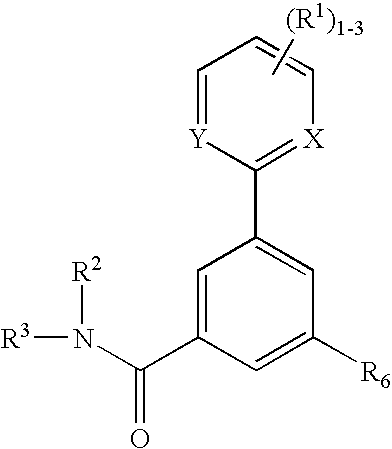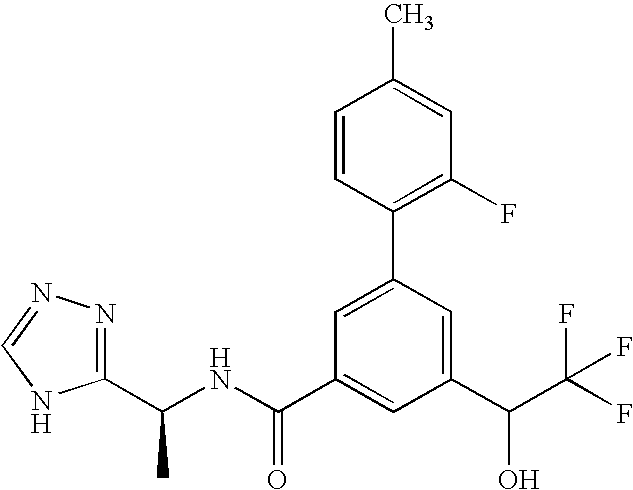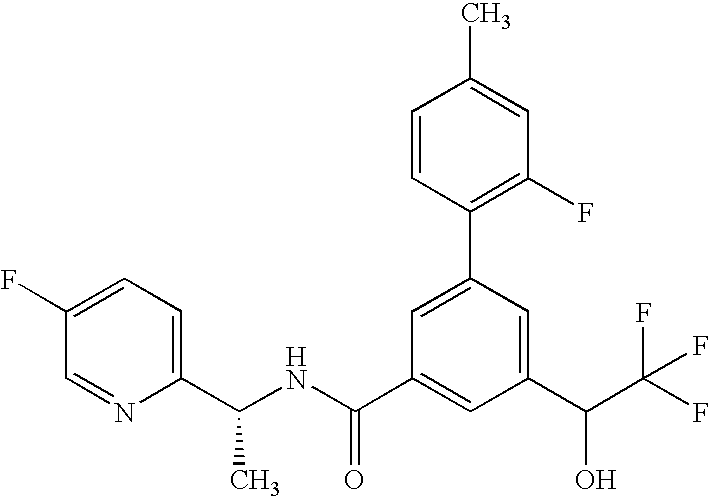P2x3 receptor antagonists for treatment of pain
a p2x3 receptor and antagonist technology, applied in the field of compounds, can solve the problems of complex utility of purinergic ligands available to evaluate the role of individual p2 receptor subtypes in mammalian physiology, intense pain, and pronounced increase in sensory nerve discharg
- Summary
- Abstract
- Description
- Claims
- Application Information
AI Technical Summary
Benefits of technology
Problems solved by technology
Method used
Image
Examples
example 1.10
[0174]
N-[(1R)-1-(5-Fluoropyridin-2-yl)ethyl]-3-(5-methylpyridin-2-yl)-5-[(R / S)-2,2,2-trifluoro-1-hydroxyethyl]benzamide
Step A: tert-Butyl 3-bromo-5-[(R / S)-2,2,2-trifluoro-1-hydroxyethyl]benzoate
[0175]To a solution of tert-butyl 3-bromo-5-formylbenzoate (5.7 g, 20.0 mmol) in tetrahydrofuran (133 mL) at 0° C. were added trimethyl(trifluoromethyl)silane (4.44 mL, 30.0 mmol) and activated 4 Å molecular sieves. Tetrabutylammonium fluoride (1.0 M in THF; 6.0 mL, 6.0 mmol) was added dropwise. The reaction mixture was warmed to ambient temperature. After 3 h, aqueous 1N HCl (25 mL) and tert-butyl methyl ether (100 mL) were added. The organic layer was separated, washed with brine, dried over sodium sulfate, filtered and concentrated.
Step B: tert-Butyl 3-(5-methylpyridin-2-yl)-5-[(R / S)2,2,2-trifluoro-1-hydroxyethyl]benzoate
[0176]To a solution of tert-butyl 3-bromo-5-(2,2,2-trifluoro-1-hydroxyethyl)benzoate (5.0 g, 14.1 mmol) and bis(tri-tert-butylphosphine)palladium(0) (0.22 g, 0.42 mmol) in...
example 1.24
[0179]
[0180]4′-Methyl-N-(2,2,2-trifluoroethyl)-5-(2,2,2-trifluoro-1-hydroxyethyl)biphenyl-3-carboxamide
Step A: tert-butyl 4′-methyl-5-(2,2,2-trifluoro-1-hydroxyethyl)biphenyl-3-carboxylate
[0181]To a mixture of Intermediate 3 (2.0 g, 5.6 mmol) (4-methylphenyl)boronic acid (1.0 g, 7.3 mmol), Pd[P(Ph3)]4 (0.32 g, 0.28 mmol), and K2CO3 (2.3 g, 17 mmol) under N2 was added 75 mL of degassed n-Propanol / water (4:1). The reaction was heated to 85° C. overnight. The mixture was cooled to room temperature and filtered over celite. The crude material was taken up in EtOAc and water. The organic layer was extracted (3×) and washed with brine. The final organic layer was dried over Na2SO4, filtered and concentrated to 2.8 g of crude material. Purification using automated flash chromatography (SiO2, 120 g, 0-20% EtOAc / Hex) gave, upon concentration, title product.
Step B: 4′-methyl-5-(2,2,2-trifluoro-1-hydroxyethyl)biphenyl-3-carboxylic acid
[0182]To a DCM (22 mL) solution tert-butyl 4′-methyl-5-(2,2...
example 1.46
[0184]
3-(5-Fluoropyridin-2-yl)-N-{(1R)-1-[1-oxido-6-(trifluoromethyl)pyridin-3-yl]ethyl}-5-[(R or S)-2,2,2-trifluoro-1-hydroxyethyl]benzamide
Step A: tert-butyl 3-bromo-5-[(R or S)-2,2,2-trifluoro-1-hydroxyethyl]benzoate
[0185]Intermediate 8 was separated by chiral chromatography (ChiralPak AD-H, 30×250 mm, 95 / 5: CO2 / EtOH, 70 mL / min, UV at 214 nm). The first eluded peak was carried onto the next step.
Step B: tert-butyl 3-(5-fluoropyridin-2-yl)-5-[(R or S)-2,2,2-trifluoro-1-hydroxyethyl]benzoate
[0186]To a solution of tent-butyl 3-bromo-5-[(R or S)-2,2,2-trifluoro-1-hydroxyethyl]benzoate (2.0 g, 5.63 mmol) in DMF (30 mL) were added 5-fluoro-2-(4,4,5,5-tetramethyl-1,3,2-dioxaborolan-2-yl)pyridine (2.51 g, 11.3 mmol), cesium carbonate (4.59 g, 14.1 mmol), dichloro[1,1′-bis(diphenylphosphino)ferrocene] (0.31 g, 0.56 mmol) and palladium acetate (0.06 g, 0.28 mmol) and copper(I) chloride (0.56 g, 5.63 mmol). The mixture was heated to 100° C. After 1 h, the mixture was cooled to ambient tempe...
PUM
| Property | Measurement | Unit |
|---|---|---|
| Diastereomer | aaaaa | aaaaa |
| Enantiomer | aaaaa | aaaaa |
Abstract
Description
Claims
Application Information
 Login to View More
Login to View More - R&D
- Intellectual Property
- Life Sciences
- Materials
- Tech Scout
- Unparalleled Data Quality
- Higher Quality Content
- 60% Fewer Hallucinations
Browse by: Latest US Patents, China's latest patents, Technical Efficacy Thesaurus, Application Domain, Technology Topic, Popular Technical Reports.
© 2025 PatSnap. All rights reserved.Legal|Privacy policy|Modern Slavery Act Transparency Statement|Sitemap|About US| Contact US: help@patsnap.com



